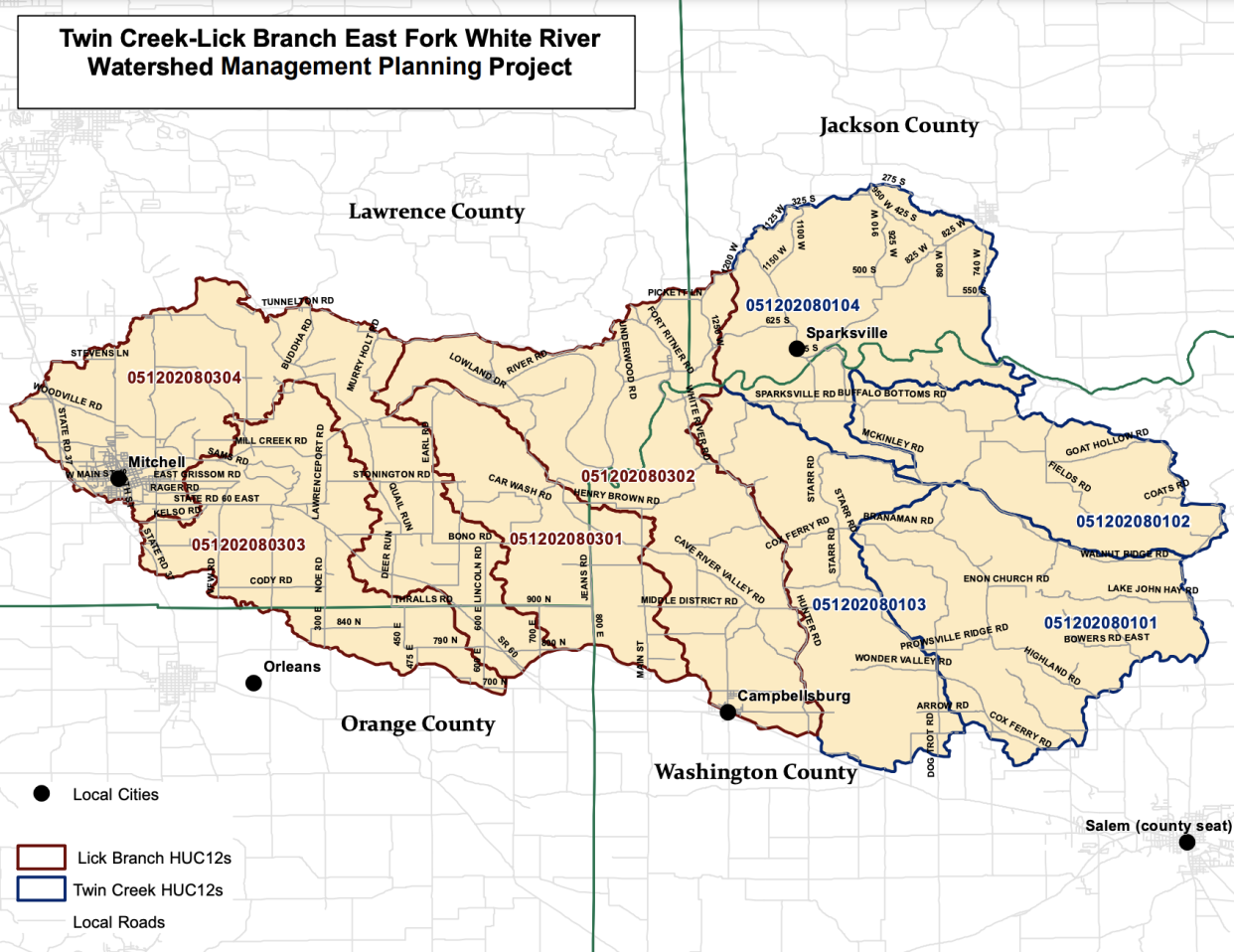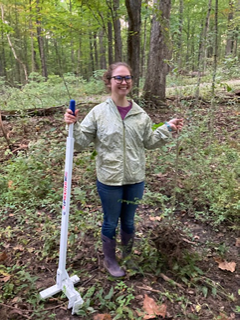Lawrence County moving forward with Twin Creek Lick Branch Watershed Project

LAWRENCE COUNTY — The Twin Creek Lick Branch Watershed is the site of an ongoing water quality project that has been in the making for the last three years.
The project focuses on the watershed, which is part of the winding White River.
The watershed consists of 117,000 acres across several different counties including Lawrence, Washington, Orange and Jackson. Large portions of the watershed are located in Lawrence and Washington counties in particular.
Local news: Mitchell Tri Kappa celebrates 100 years of doing good.
Twin Creek Lick Branch is connected to another watershed: Lower East Fork White, which extends around 207 square miles across southwest Indiana. Residents in these areas rely on the watershed for drinking water, as well as agricultural and recreational activities.
Valerie Baird, who works as a watershed coordinator at Washington County Water and Soil Conservation District, said the project will conduct an assessment of the watershed and its overall health. This will be done by analyzing the water quality of the multiple waterways in the area.
Baird and other specialists will then test the water to detect the presence of any potentially harmful bacteria. The project will also feature the implementation of proactive measures, such as stream monitoring.
"So this plan is going to take a look at the current lay of the land in the watershed, what's going on from an urban and residential standpoint, from an agricultural standpoint and from an industrial standpoint," she said. "It is just a holistic picture of what's happening in the watershed, like 'What kind of topography do we have? Do we have a lot of forests? Do we have a lot of crops? Do we have a lot of developed land? And how is the water draining through?'"
What are watersheds and why are they important?
Watersheds are important for their ability to drain water into rivers, lakes or oceans. A watershed is typically defined as land that is surrounded by ridges or hills, creating a basin where precipitation, stormwater runoff and percolation drains into.
They are responsible for providing clean air, water and soil to people, plants and animals. Other important functions include water and nutrient cycling, recharging groundwater, as well as the collection of rain and snowmelt. Watersheds are also important for absorbing greenhouse gas emissions.
Background and goals of the project
The project consists of multiple phases and has been in development for the last three years. Baird confirmed that she and her colleagues are currently in the watershed management plan phase, meaning efforts are underway to write a watershed management plan.
Others are reading: Indiana Congressman Trey Hollingsworth won't seek reelection in 2022.
The groundwork for this project started to materialize much earlier in Washington County. In years past, other watersheds and natural areas in the county had received cost-share funds to subsidize conservation practices. That prompted locals to explore funding opportunities to maintain the Twin Creek Lick Branch Watershed.
"So then this Twin Creek watershed was identified as an area that wasn't actively receiving any funds," Baird said. "So that presented it as an opportunity to seek out support from producers to bring money to that area. So that's kind of what kickstarted the grant writing process."
The grant for the watershed management plan was initially submitted in 2019. The Washington Soil and Water Conservation District got approval in September of last year to begin presenting the project to the public.
Baird previously provided an overview of the Twin Creek Lick Branch Watershed project at a county commissioner meeting last month. During that meeting, she offered a breakdown of the various phases of the project.
One of the most important steps is the formation of a steering committee to assist with data collection and helping with other tasks throughout the duration of the project. Baird had asked if the commissioners could provide recommendations of any Lawrence County residents who might be interested in contributing as a member of the steering committee.
"We're in the process of reaching out to some folks that the county commissioners recommended," Baird said.
Baird has also been collaborating with Lawrence County's Soil and Water Conservation District to search for key stakeholders to serve on the project's steering committee and contribute to the writing of the watershed management plan.
Bedford: Police and ATF investigation of Cosner's burglary leads to five arrests.
"We're putting together a steering committee of all these key individuals to help weigh in on writing this plan," Baird said. "When we submit it back to the Indiana Department of Environmental Management, this plan dictates which projects they're going to choose to fund or not. Funding means that cost-share money comes back to the county."
The steering committee will be comprised of county officials, landowners, agricultural producers and technical experts. Baird said the steering committee has already held one of its many planned meetings. The committee will convene at least nine times until the planning phase concludes in January of 2024.
Hannah Martin, a conservation resource technician at Lawrence County Soil and Water Conservation District, agreed that the steering committee is still in the process of being finalized.

"We're working with Valerie on that," Martin said. "She has done a great job at trying to make sure that we have a diverse audience of everyone who is involved. We're definitely trying to still recruit people. So Lawrence County could use some assistance in recruiting people to be involved in our steering committee."
Once every available spot on the steering committee is filled, the next steps involve developing a watershed management plan.
"So in this watershed management planning phase, we're taking a look at the landscape," Baird said. "We're gathering interest from stakeholders from different groups. So, I presented at the county commissioner's meeting because we want our city and elected officials to be involved in what we're doing."
Once the watershed management plan is fully prepared, Baird said she expects it to be ready for submission sometime around April. This plan will prioritize securing cost-share funds to bring money back into the four counties, giving landowners and producers a platform to continue implementing conservation practices in the future.
"The ultimate goal is to bring dollars back to our area to help improve the conservation of the land across rural and urban areas while improving the quality of water that flows above ground," she said.
Several key locations will be assessed throughout the designated watershed project area.
Bedford Plan Commission: Land request advances to public hearing.
"We're going to start a yearlong water monitoring project," she said. "We're going to have professionals and volunteers. We've identified 13 key locations throughout the watershed area that are going to give us a really good snapshot of the current status of the water. As we get that data in, and if the steering committee has a chance to evaluate it, that'll really help us drive what conservation projects we can bring to the land that will help improve the land, soil and water so that it's a better environment for residents, landowners, producers and visitors."
Baird stressed the importance of making people understand that the Twin Creek Lick Branch Watershed project does not mean there is an issue with the water already present in the watershed.
"Just because a project is happening doesn't mean there's a concern or something harmful going on," she explained. "We're trying to be very proactive in seeking funding to make improvements."
Anyone interested in becoming a member of the project's steering committee or would like to receive more information about the project and volunteering opportunities can reach Valerie Baird at valerie.baird@in.nacdnet.net or 812-883-3006 ext. 3.
"Anyone can be a part of this steering committee," Martin said. "Anyone who has any interest in improving the water quality of the areas, whether that be urban, agricultural or business-related."
This article originally appeared on The Times-Mail: Lawrence County part of Twin Creek Lick Branch Watershed Project

